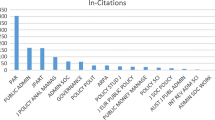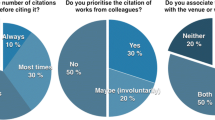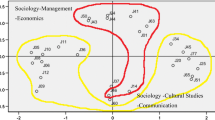Abstract
This paper describes the results of a multi-level network analysis of web-citations among the 1,000 universities with the greatest presence on the world wide web. Using data from January 2011, it describes the web-citation network of the world’s universities and ascertains the antecedent factors that determine its structure. At the university level, the network is composed of ten groups, and the most central universities are mainly from the United States. The factors that predict the structure of the network are, whether or not the universities are in the same country, the language of instruction, the size and excellence of the institution (university ranking and the number of Nobel Prizes received), if they offer doctoral degrees, and the infrastructure of its country. Physical distance was not a determinant of the network’s structure. At the nation-state level, international connections among a nation’s universities are composed of a single cluster with the United States, United Kingdom and Germany at the center. The structure of the international network may be predicted by the countries’ overall hyperlink connections, international co-authorships, student flows and the number of Nobel Prizes won by its citizen.
Similar content being viewed by others
References
Almind, T. C., & Ingwersen, P. (1997). Informetric analyses on the world wide web: Methodological approaches to ‘Webometrics’. Journal of Documentation, 53(4), 404–426.
Barnett, G. A. (2001). A longitudinal analysis of the international telecommunications network: 1978–1996. American Behavioral Scientist, 44(10), 1638–1655.
Barnett, G. A. (2005). An Introduction to self-organizing systems. In G. A. Barnett & R. Houston (Eds.), Advances in self-organizing systems (pp. 3–32). Cresskill: Hampton Press.
Barnett, G. A. (2011). Communication and the evolution of SNS: Cultural convergence perspective. Journal of Contemporary Eastern Asia, 10(1), 43–54.
Barnett, G. A., & Choi, Y. (1995). Physical distance and language as determinants of the international telecommunication network. International Political Science Review, 16, 249–265.
Barnett, G. A., Chon, B. S., Park, H. W., & Rosen, D. (2001). An examination of international Internet flows: An autopoietic model. Paper presented to the International Communication Association, Washington.
Barnett, G. A., Jacobson, T. L., Choi, Y., & Sun-Miller, S. L. (1996). An Examination of the international telecommunication network. The Journal of International Communication, 3, 19–43.
Barnett, G. A., & Park, H. W. (2005). The structure of international internet hyperlinks and bilateral bandwidth. Annals of Telecommunication, 60, 1115–1132.
Barnett, G. A., & Park, H. W. (2012). Examining the international internet using multiple measures: New methods for measuring the communication base of globalized cyberspace. Quality and Quantity. doi:10.1007/s11135-012-9787-z.
Barnett, G. A., & Salisbury, J. G. T. (1996). Communication and globalization: A longitudinal analysis of the international telecommunication network. Journal of World-Systems Research, 2(16), 1–17.
Barnett, G. A., Salisbury, J. G. T., Kim, C., & Langhorne, A. (1999). Globalization and international communication networks: An examination of monetary, telecommunications, and trade networks. The Journal of International Communication, 6, 7–49.
Barnett, G. A., & Sung, E. (2006). Culture and the structure of the international hyperlink network. Journal of Computer-Mediated Communication, 11(2), 17–38.
Barnett, G. A., & Wu, Y. (1995). The international student exchange network: 1970 and 1989. Higher Education, 30, 353–368.
Bonacich, P. (1972). Factoring and weighting approaches to status scores and clique identification. Journal of Mathematical Sociology, 2(1), 113–120.
Borgatti, S. P., Everett, M. G., & Freeman, L. C. (2002). UNICET 6 for Windows: Software for social network analysis [Computer Program]. Needham, MA: Analytic Technologies.
Burt, R. S. (1992). Structural holes: The social structure of competition. Cambridge: Harvard University Press.
Chakrabarti, S., Dom, B. E., Kumar, S. R., Raghavan, P., Rajagopalan, S., Stata, R., Tomkins, A., Gibson, D., & Kleinberg, J. (1999). Mining the Web’s link structure. Computer, 32(8), 60–67.
Chase-Dunn, C., & Grimes, P. (1995). World-systems analysis. Annual Review of Sociology, 21, 387–417.
Chen, T. M., & Barnett, G. A. (2000). Research on international student flows from a macro perspective: A network analysis of 1985, 1989 and 1995. Higher Education, 39, 435–453.
Choi, S., & Park, H. W. (2014, forthcoming). An exploratory approach to a Twitter-based community centered on a political goal in South Korea: Who organized it, what they shared, and how they acted. New Media & Society.
Chung, C. J., & Park, H. W. (2012). Web visibility of scholars in media and communication journals. Scientometrics, 93(1), 207–215.
Chung, C. J., Cho, S. E., & Park, H. W. (2013). SNS use by the Korean Government: A case of Me2Day. Asian Journal of Communication, 23(6).
Chung, C. J., Barnett, G. A., & Park, H. W. (2013). Inferring international dotcom web communities by link and content analysis. Quality & Quantity. doi:10.1007/s11135-013-9847-z.
College Board. (2012). College handbook 2012. New York: College Board.
De Maeyer, J. (2012). Towards a hyperlinked society: A critical review of link studies. New Media & Society. doi:10.1177/1461444812462851.
Doz, Y. L., Oik, P. M., & Ring, P. S. (2000). Formation processes of R&D consortia: Which path to take? Where does it lead? Strategic Management Journal, 21, 239–266.
EUMIDA (2010) European University data collection. Retrieved July 12, 2012 from http://thedatahub.org/dataset/eumida.
Glänzel, W. (2001). National characteristics in international scientific co-authorship relations. Scientometrics, 51, 69–115.
Heimeriks, G., & Van Den Besselaar, P. (2006). Analyzing hyperlinks networks: The meaning of hyperlink based indicators of knowledge production. Cybermetrics, 10(1). http://cybermetrics.cindoc.csic.es/articles/v10i1p1.html. Accessed 21 June 2013.
Ingwersen, P. (1998). The calculation of web impact factors. Journal of Documentation, 54, 236–243.
Khan, G. F., Yoon, H. Y., & Park, H. W. (2013). Social media communication strategies of government agencies: Twitter use in Korea and the U.S. Asian Journal of Communication, 23(6)
Khan, G. F., Yoon, H. Y., Kim, J. Y., & Park, H. W. (2014). From E-Government to social government: The case of twitter use by Korea’s Central Government. Online Information Review, 38(1).
Krackhardt, D. (1987). QAP partialling as a test for spuriousness. Social Networks, 9, 171–186.
Krippendorf, K. (1991). Society as self-referential. Journal of Communication, 41, 136–140.
Kwon, K.-S., Park, H. W., So, M. H., & Leydesdorff, L. (2012). Has globalization strengthened South Korea’s national research system? National and international dynamics of the triple helix of scientific co-authorship relationships in South Korea. Scientometrics, 90(1), 163–176.
Lechner, F. J., & Boli, J. (2005). World culture: Origins and consequences. Oxford: Blackwell.
Lee, M., & Park, H. W. (2012). Exploring the web visibility of world-class universities. Scientometrics, 90, 201–218.
Leydesdorff, L. (2007). ‘‘Betweenness centrality’’ as an indicator of the ‘‘interdisciplinarity’’ of scientific journals. Journal of the American Society for Information Science and Technology, 58(9), 1303–1309.
Leydesdorff, L., & Wagner, C. S. (2008). International collaboration in science and the formation of a core group. Journal of Informetrics, 2, 317–325.
Leydesdorff, L., Wagner, C., Park, H. W., & Adams, J. (2013). International collaboration in science: The global map and the network. El professional de la Información, 22(1), 87–94.
Li, X., Thelwall, M., Musgrove, P., & Wilkinson, D. (2003). The relationship between the links/web impact factors of computer science departments in UK and their RAE (Research Assessment Exercise) ranking in 2001. Scientometrics, 57(2), 239–255.
Lim, Y. S., & Park, H. W. (2013). The structural relationship between politicians’ web visibility and political finance networks: A case study of South Korea’s national assembly members. New Media & Society, 15(1), 93–108.
Manturana, H. R., & Varela, F. J. (1980). Autopoiesis and cognition: The realization of the living. Dordrecht: D. Reidel.
Handcock, M. S., Hunter, D. R, Butts, C. T, Goodreau, S. M., & Morris M. (2003). statnet: Software tools for the statistical modeling of network data. http://statnetproject.org. Accessed 21 June 2013.
Monge, P. R., & Contractor, N. S. (2003). Theories of communication networks. Oxford: Oxford University Press.
Moon, S., Barnett, G. A., & Lim, Y. S. (2010). The structure of International music flows using network analysis. New Media and Society, 12(3), 379–399.
Nam, Y., & Barnett, G. A. (2011). Globalization of technology: Network analysis of global patents and trademarks. Technological Forecasting and Social Change, 78(8), 1471–1485.
Nam, Y., Lee, Y.-O., & Park, H. W. (2013). Can web ecology provide a clearer understanding of people’s information behavior during election campaigns? Social Science Information, 52(1), 91–109.
OECD (2012). Education at a glance 2012: OECD Indicators, OECD Publishing. http://dx.doi.org/10.1787/eag-2012-en. Accessed 21 June 2013.
Opsahl, T., Colizza, V., Panzarasa, P., & Ramasco, J. J. (2008). Prominence and control: The weighted rich-club effect. Physical Review Letters, 101, 168702.
Ortega, J. L., & Aguillo, I. F. (2007). La Web académica española en el contexto del Espacio Europeo de Educación Superior: Estudio exploratorio. El profesional de la Información, 16(5), 417–425.
Ortega, J. L., & Aguillo, I. F. (2008). Linking patterns in the European Union’s Countries: Geographical maps of the European academic web space. Journal of Information Science, 34(5), 705–714.
Ortega, J. L., & Aguillo, I. F. (2009). Mapping world-class universities on the web. Information Processing and Management, 45, 272–279.
Park, H. W. (2010). Mapping the e-science landscape in South Korea using the webometrics method. Journal of Computer-Mediated Communication, 15(2), 211–229.
Park, H. W., Barnett, G. A., & Chung, C. J. (2011a). Structural changes in the 2003–2009 global hyperlink network. Global Networks, 11(4), 522–542.
Park, H. W., & Leydesdorff, L. (2010). Longitudinal trends in networks of university-industry-government relations in South Korea: The role of programmatic incentives. Research Policy, 39(5), 640–649.
Park, S. J., Lim, Y. S., Sams, S., Sang, M. N., & Park, H. W. (2011b). Networked politics on cyworld: The text and sentiment of Korean political profiles. Social Science Computer Review, 29(3), 288–299.
Park, H. W., & Thelwall, M. (2006). Web science communication in the age of globalization. New Media & Society, 8(4), 629–650.
Payne, N., & Thelwall, M. (2004). A statistical analysis of UK academic web links. Cybermetrics, 8(1), 2.
Rivera, M. T., Soderstrom, S. B., & Uzzi, B. (2010). Dynamics of dyads in social networks: Assortative relational, and proximity mechanisms. Annual Review of Sociology, 36, 11–91.
Sams, S., & Park, H. W. (2013). The presence of hyperlinks on social network sites: A case study of Cyworld in Korea. Journal of Computer-Mediated Communication , 19(1).
Seeber, M., Lepori, B., Lomi, A., Aguillo, I., & Barberio, V. (2012). Factors affecting web links between European higher education institutions. Journal of Informetrics, 6, 435–447.
Shumate, M., & Lipp, J. (2008). Connective collective action online: An examination of the hyperlink network structure of an NGO issue network. Journal of Computer-Mediated Communication, 14, 178–201.
Tang, R., & Thelwall, M. (2004). Patterns of national and international web inlinks to US academic departments: An analysis of disciplinary variations. Scientometrics, 60(3), 475–485.
Tehranian, M. (1990). Technologies of power: Information machines and democratic prospects. Norwood: Ablex.
Thelwall, M. (2002a). A research and institutional size based model for national university web site interlinking. Journal of Documentation, 58(6), 683–694.
Thelwall, M. (2002b). Evidence for the existence of geographic trends in university web site interlinking. Journal of Documentation, 58(5), 563–574.
Thelwall, M., & Sud, P. (2011). A comparison of methods for collecting web citation data for academic organisations. Journal of the American Society for Information Science and Technology, 62(8), 1488–1497.
Thelwall, M., Sud, P., & Wilkinson, D. (2012). Link and co-inlink network diagrams with URL citations or title mentions. Journal of the American Society for Information Science and Technology, 63(4), 805–816.
Thelwall, M., Tang, R., & Price, L. (2003). Linguistic patterns of academic web use in Western Europe. Scientometrics, 56(3), 417–432.
Thelwall, M., & Zuccala, A. (2008). A University-Centred European union link analysis. Scientometrics, 75(3), 407–420.
Vaughan, L., & Thelwall, M. (2005). A modeling approach to uncover hyperlink patterns: The case of Canadian universities. Information Processing and Management, 41(2), 347–359.
Wagner, C. S. (2008). The new invisible college. Washington, DC: Brookings Press.
Wallerstein, I. (1974). The modern world system. New York: Academic Press.
Weber, M., & Monge, P. R. (2011). Network evolution. In G. A. Barnett (Ed.), Encyclopedia of social networks (pp. 600–606). Los Angeles: Sage.
Acknowledgments
The authors would like to thank Loet Leydesdorff, Jessie Hammond, Haley Pleasant, and Jeanette Ruiz without whom this paper would not have been possible. The corresponding author acknowledges a partial support from the SSK (Social Science Korea) Program funded by National Research Foundation of South Korea; NRF-2010-330-B00232.
Author information
Authors and Affiliations
Corresponding author
Rights and permissions
About this article
Cite this article
Barnett, G.A., Park, H.W., Jiang, K. et al. A multi-level network analysis of web-citations among the world’s universities. Scientometrics 99, 5–26 (2014). https://doi.org/10.1007/s11192-013-1070-0
Received:
Published:
Issue Date:
DOI: https://doi.org/10.1007/s11192-013-1070-0




